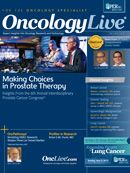Publication
Article
Resistance Poses Challenges in Chemotherapy Options
Author(s):
While chemotherapy might initially be effective in the treatment of patients with metastatic breast cancer, it is very common for patients to develop resistance to such agents.
William J. Gradishar, MD
Betsy Bramsen Professor of Breast Oncology, Director, Maggie Daley Center for Women’s Cancer Care,
Robert H. Lurie Comprehensive Cancer Center, Northwestern University Feinberg School of Medicine, Chicago, IL
While chemotherapy might initially be effective in the treatment of patients with metastatic breast cancer, it is very common for patients to develop resistance to such agents. This dilemma represents one of the major challenges in the effective management of breast cancer, prompting the need to explore new chemotherapeutic agents and ways to make the most of those currently available.
William J. Gradishar, MD, director of the Maggie Daley Center for Women’s Cancer Care in Chicago, Illinois, discussed options for clinicians facing this challenge during the 30th Annual Miami Breast Cancer Conference in March.
“As you treat with different regimens, the fraction of patients that are going to gain a benefit or respond diminishes, so that by the time you’re in the third, fourth, fifth, or beyond line of therapy, the fraction of patients responding is usually less than 20%,” Gradishar said. “And very frequently, their overall performance status declines because of the disease, and their ability to tolerate therapy also declines, so they start to experience the side effects in a more magnified way.”
Gradishar said that many of the agents used to treat metastatic breast cancer—anthracyclines, taxanes, and cyclophosphamides—are used in the adjuvant setting, so when a patient develops recurrent disease, the tumors already will have been exposed to those agents. Therefore, other therapies are required to treat recurrences.
One such therapy is eribulin mesylate (Halaven), a nontaxane microtubule dynamics inhibitor that the FDA approved in 2010 for use in metastatic breast cancer previously treated with an anthracycline and a taxane in either the adjuvant or metastatic setting, and with at least two cytotoxic chemotherapy regimens for metastatic disease. Gradishar said that, while eribulin has not been shown to be the “magic bullet” that eradicates metastatic disease, it appears to be well-tolerated and can be given safely, even if a patient has received multiple prior lines of therapy.
A study presented at the San Antonio Breast Cancer Symposium in December 2012 revealed mixed results. The phase III trial compared eribulin with capecitabine in patients with locally advanced or metastatic breast cancer who had received no more than three prior chemotherapy regimens (no more than two regimens for advanced disease).
The study found that that the median overall survival (OS) was 15.9 months for patients who received eribulin compared with 14.5 months for those who received capecitabine (hazard ratio [HR] = 0.879; 95% CI, 0.770-1.003; P = .056). The median progression-free survival was 4.1 months and 4.2 months, respectively (HR = 1.079; 95% CI, 0.932-1.250; P = .305). Overall response rates (ORR) were similar between the two arms, with an ORR of 11% for eribulin and 12% for capecitabine (P = .849).
Gradishar said there are two ways of viewing this study. On the one hand, the study showed that eribulin, a fairly new and expensive chemotherapeutic agent, was not superior to its older, less expensive counterpart. However, he pointed out that when capecitabine first became available, it was initially viewed as a salvage therapy, but now is frequently used in earlier lines of treatment for metastatic breast cancer.
“The good-news way of looking at that dataset is that eribulin appears to be very similar to capecitabine, so rather than just salvage, it could be used in earlier lines of treatment of metastatic disease,” Gradishar said.
Additionally, eribulin appears to be a superior option for patients who have HER2-negative disease. In that group, the median OS was 15.9 months for those who received eribulin compared with 13.5 months for those who received capecitabine (HR = 0.838; 95% CI, 0.715-0.983; P = .030).
Gradishar said there is no optimal algorithm for sequencing chemotherapeutic agents. Instead, he said clinicians must look at a patient’s performance status and determine not only what therapies would work best, but also be most tolerable.
“You have to sort of look at what’s on your palette of possibilities and make a decision, because often times, one therapy is not necessarily better than another, but they may have toxicities that make one drug more attractive than another,” Gradishar said. He added that, for example, “If somebody has severe neuropathy, you try to avoid giving a drug that’s only going to exacerbate what they already have.”
Kaufman PA, Awada A, Twelves C, et al. A phase III, open-label, randomized, multicenter study of eribulin mesylate versus capecitabine in patients with locally advanced or metastatic breast cancer previously treated with anthracyclines and taxanes. Presented at: 2012 CTRC-AACR San Antonio Breast Cancer Symposium; December 4-8, 2012; San Antonio, TX. Abstract S6-6.










